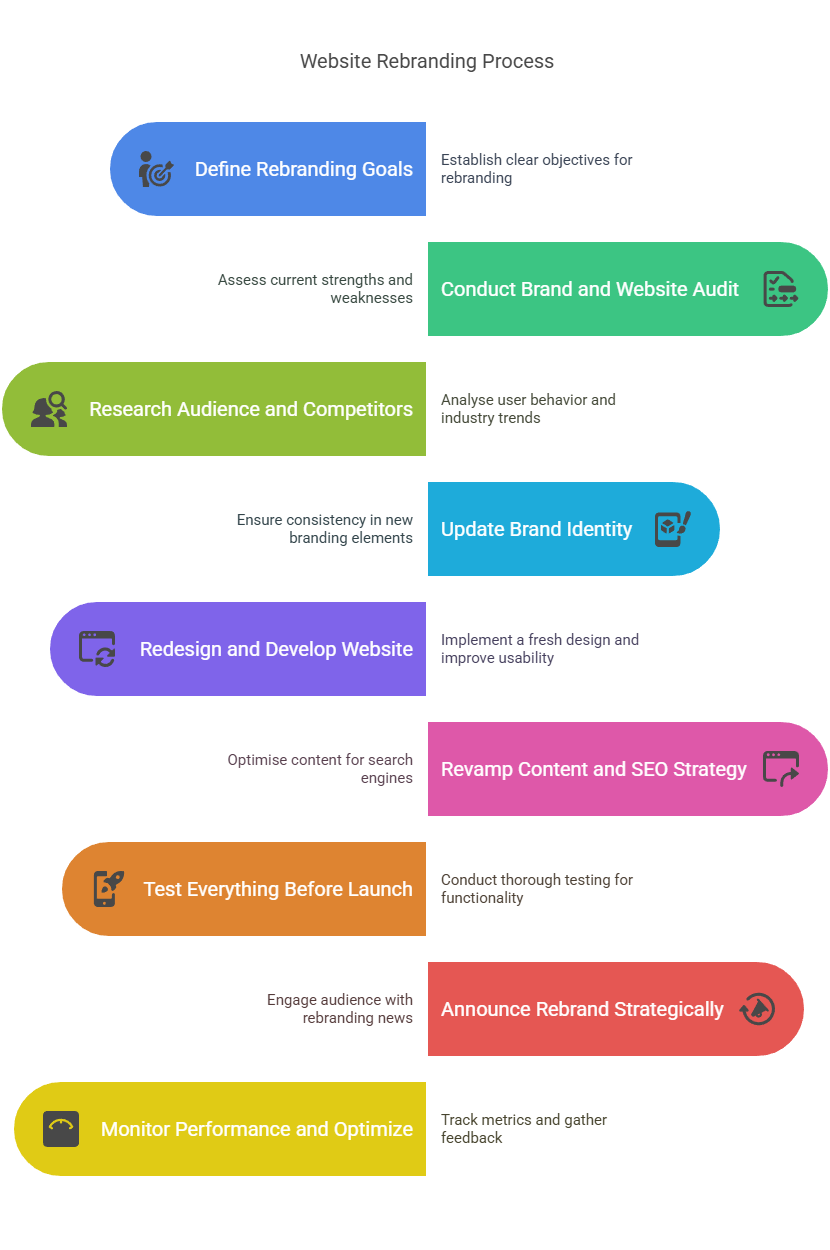Key Takeaways
- Website rebranding involves updating design, content, and user experience to align with business goals and market trends.
- Rebranding types include visual, content, structural, and strategic changes.
- Businesses should rebrand when facing outdated designs, poor engagement, brand repositioning, or competition.
- Rebranding frequency varies; B2B companies often update every 5-7 years, with minor updates every 2-3 years.
- Website rebranding agencies can help mitigate risks and ensure a smooth transition.
- Use a rebranding checklist in this article and advice on announcing the rebrand to customers.
In today’s volatile market, businesses will face market shifts, engagement decline, outdated tech, or mergers. As such, they must rebrand themselves in order to stay relevant and ahead of the competition. Website rebranding is more than just changing up its looks; it's a strategic decision that seeks to enhance the user experience, strengthen brand identity, and improve market competitiveness.
This guide covers the basics of rebranding, the best times to rebrand, and how a professional agency can help.
What is Rebranding of a Website?
Website rebranding is the process of refreshing your website’s design, content, and user experience to align with your new brand identity and match the evolving needs of your target audience.
There are several types of rebranding, including:
- Visual Rebranding: Revamping the visual elements of a website, such as a logo, colour scheme, typography, and imagery.
- Content Rebranding: Changing the site’s content to reflect the new brand message or values. This may include rewriting copies, adding new pages, or updating existing content.
- Structural Rebranding: Reformatting the structure and functionality of the website, including updating the navigation, adding new features, or improving the user experience.
- Strategic Rebranding: Updating the overall brand strategy, including changes to the target audience, messaging, or value proposition.
Key elements of a website rebrand:
- Design: New UI/UX elements, colour schemes, and layout improvements.
- Content: Updated messaging, tone, and information architecture.
- Branding Strategy: Logo updates, typography, and brand consistency.
- SEO Optimization: Maintaining or improving search rankings.
What is the Purpose of Rebranding?
Website rebranding is more than just refreshing your website’s aesthetics; it is an important step towards modernising your brand’s image, repositioning it in an increasingly competitive environment, and expanding into new market sectors or customer bases.
This, in turn, leads to increased traffic, enhanced user experiences, higher audience engagement, and improved conversion rates.
How Often Should You Rebrand Your Website?
There’s no one-size-fits-all answer to how often you should update your website. It all depends on industry and market trends, your business needs, brand goals, and available resources, including budget, time, and personnel.
Signs That Indicate It’s Time for a Website Rebrand
1. Outdated Design and User Experience
If your website looks outdated compared to competitors, has slow load times, or isn't mobile-friendly, it’s time for a redesign. User expectations evolve rapidly, and an old-fashioned website can turn potential customers away.
2. Repositioning or Business Growth
Has your company expanded its services, changed its target audience, or undergone a merger? A rebrand helps align your website with your new business identity and goals.
3. Poor Performance and Low Engagement
High bounce rates, declining conversions, and poor SEO rankings indicate that your website isn’t resonating with users. A rebrand can improve navigation, content, and aesthetics to increase engagement.
4. Inconsistent Branding Across Channels
If your website’s branding doesn’t match your social media, marketing materials, or overall brand identity, it creates confusion. A website rebrand ensures consistency across all channels.
5. Shift in Industry Trends or Competition
If competitors in your industry have updated their websites and branding while yours remains unchanged, you risk falling behind. Staying relevant requires periodic updates to match current industry standards.
Industry Trends: How Often Do Businesses Rebrand?
Different industries have different needs. Thus, how often they rebrand their websites depends on their current goals and market trends:
- B2B Website Rebranding: Many B2B companies refresh their branding every 5-7 years, though minor updates (such as UI/UX improvements) happen every 2-3 years to stay competitive.
- Blue-Collar Business Rebranding: Trades and blue-collar businesses (construction, manufacturing, HVAC, etc.) may not need frequent full rebrands. However, updates every 5-10 years can keep their website professional and modern, with small updates (such as new service pages or SEO improvements) happening annually.
As shown below, the two different website rebranding strategies target different business needs and audiences. B2B strategies prioritise establishing authority, generating leads, and presenting a professional design, while Blue-Collar strategies emphasise building trust, optimising local SEO, and delivering customer-centric messaging.

How Frequently Should You Rebrand Your Website?
Here are some recommended frequencies for updating your website’s branding and digital presence:
- Minor updates (content refreshes, UX/UI tweaks): Every 1-2 years
- Website redesigns (new layouts, improved functionality): Every 3-5 years
- Full rebrand (logo, messaging, and overall branding shift): Every 5-7 years
Website Rebranding Checklist
Need help in the rebranding process? Here’s a checklist of the essential steps for revamping your website:

This checklist will give you a good idea of how to smoothen the process. It provides a series of steps you can follow from the conception to the post-rebranding performance monitoring, ensuring that you have everything you need in your rebrand.
Of course, it always helps to hire the services of a website rebranding group if you want everything to go well.
How a Website Rebranding Agency Can Help You
Rebranding your website is a major undertaking that requires careful planning and execution. A website rebranding agency can guide you through this process, ensuring a seamless transition while mitigating risks like downtime and a rough UX/UI transition.
How a Website Rebranding Company Mitigates Risks
A poorly executed rebrand can lead to SEO losses, customer confusion, and functionality issues. A professional agency helps avoid these pitfalls by:
- Preserving SEO rankings: Implementing 301 redirects and maintaining structured data prevents traffic drops.
- Ensuring smooth UX/UI transitions: Expert designers create intuitive, engaging interfaces.
- Minimising downtime: Agencies ensure a seamless website launch with rigorous testing and contingency planning.
- Maintaining brand consistency: They ensure brand messaging remains clear and aligns across platforms.
How Long Does It Take to Redesign a Website?
The timeline for a website rebranding project depends on its complexity, but the process typically follows these phases:
- Strategy & Planning: Define goals, conduct audits, and research competitors. 2-4 weeks.
- Design & Branding: Create wireframes, develop branding elements, and finalize the UI/UX. 4-8 weeks.
- Development & Content: Build the website, migrate content, and integrate necessary tools. 6-12 weeks.
- Testing & Optimization: Conduct usability tests, SEO optimizations, and bug fixes. 2-4 weeks.
- Launch & Post-Launch Monitoring: Deploy the new website and monitor performance. 1-2 weeks.
Factors Affecting Project Timeline
Several factors can influence the duration of a website redesign project, including:
- Project Complexity: More complex projects with advanced features, custom designs, and extensive content updates will naturally take longer.
- Scope of Work: The extent of the redesign (minor tweaks vs. full overhaul) significantly impacts the timeline.
- Client Feedback and Approvals: Delays in feedback or approvals can extend the project timeline.
- Agency Efficiency and Resources: A professional creative agency with experienced teams and streamlined processes can complete the project faster.
A professional agency is helpful in expediting this process. They can streamline workflows, prevent common mistakes, and manage resources efficiently, ensuring a faster turnaround without compromising quality.
How Much Does It Cost to Rebrand a Website?
Of course, there’s the million-dollar question: How much will this rebrand cost me? It all varies based on a multitude of factors. For example, a professional web design firm will charge a higher price for creating a high-end, custom rebrand than a freelancer in charge of a simpler revamp. Here’s how much businesses in Malaysia pay for rebranding their websites:
Average Cost Range Based on Business Type
| Business Type | Estimated Rebranding Cost (RM) |
|---|---|
| Small businesses (basic site) | RM3,000 – RM8,000 |
| Blue-collar businesses (service-based) | RM5,000 – RM15,000 |
| B2B websites (corporate, high-end) | RM10,000 – RM50,000+ |
1. Design and Development Costs
The website's design overhaul plays a crucial role in rebranding. Costs can vary depending on whether the redesign is minor (adjusting colours and layouts) or a full-scale revamp (custom-built designs, interactive elements, and new UI/UX features).
| Design and Development Type | Estimated Rebranding Cost (RM) |
|---|---|
| Basic redesign (template-based, minimal changes) | RM2,200 – RM3,500 |
| Moderate redesign (custom layouts, responsive design, UI/UX updates) | RM4,000 – RM12,000 |
| High-end redesign (custom-built, animations, advanced UI/UX) | RM8,000 – RM100,000, depending on complexity |
2. Branding, Logo, and Content Updates
A successful website rebranding includes updating logos, brand identity elements, and content to reflect the new direction of the business.
| Rebrand Type | Estimated Rebranding Cost (RM) |
|---|---|
| Logo and brand identity refresh | RM8,000 – RM150,000 (depending on the business size and requirements) |
| Content updates (copywriting, SEO optimization, multimedia) | RM2,000 – RM8,000+ |
Conclusion
Website rebranding is a multifaceted process that can significantly improve user experience, brand visibility, and customer engagement. If you’re experiencing signs that your website needs an overhaul or a new look, now is the time to consider rebranding.
With the right team of experts, a well-executed website rebrand will help you stay ahead of the competition, boost your brand’s image, and achieve your business objectives. If you need assistance, don’t hesitate to reach out to a website rebranding agency for a consultation and detailed analysis.



